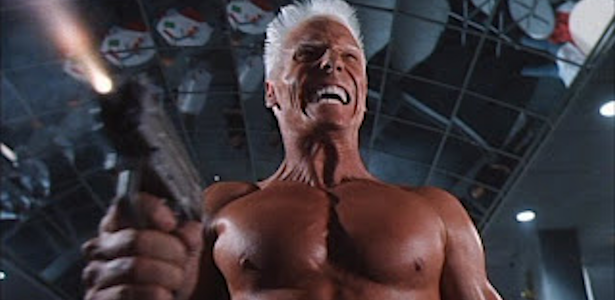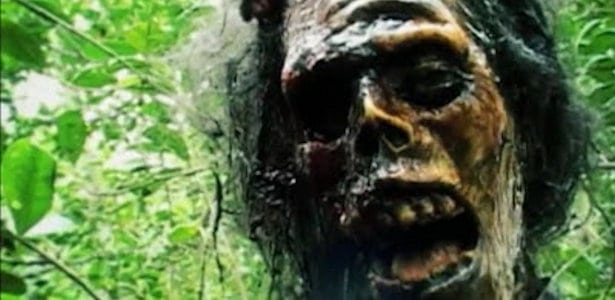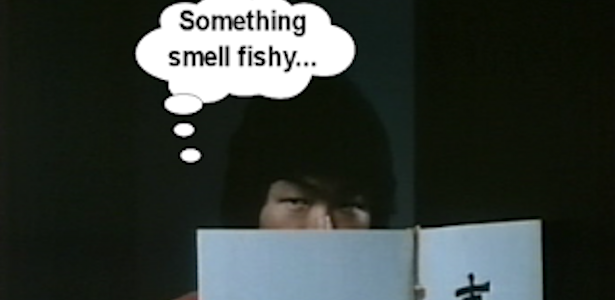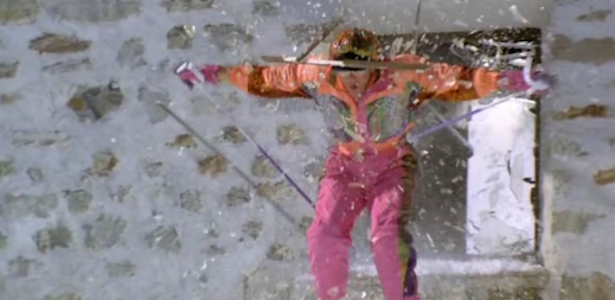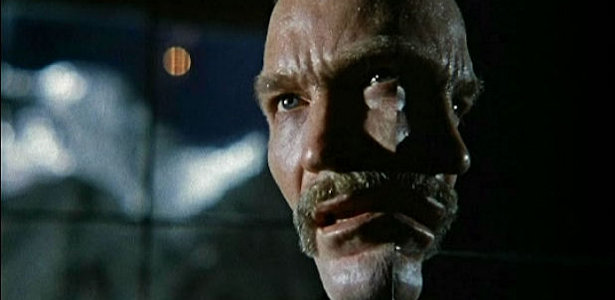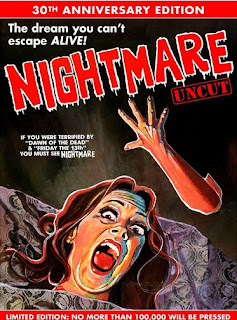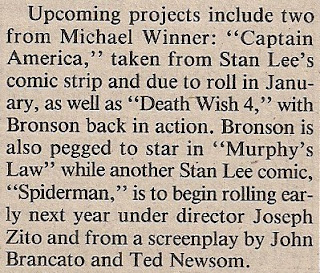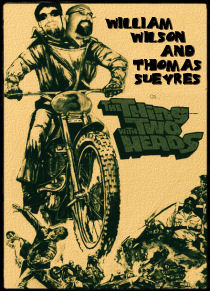We’re pretty big fans of stuntman/director Hal Needham here at Video Junkie. After all, how can you not love a man who was one of the founding fathers of the good ol’ boys, car crash cinema that dominated the 1970s and early 1980s? Needham had the fifth biggest film at the box office in 1977 with his directing debut SMOKEY AND THE BANDIT (1977) starring Burt Reynolds. He repeated that success (to a lesser degree in terms of total haul) the following year when he re-teamed with Reynolds for the stuntman saga HOOPER (1978). Both films are totally without airs as they strive to maintain their one goal – entertaining the audience – with laughs, thrills and jaw-dropping car stunts. And we’re talking the kind of vehicular stunts that involve – gasp! – real automobiles.
So it is strange after three theatrical features (Needham had THE VILLAIN coming out in July 1979 while he was filming this) that Needam would take the exit to the small screen to direct a CBS Tuesday Night Movie. For his fourth feature, Needham jumped behind (and in front of) the camera for the juicily titled DEATH CAR ON THE FREEWAY. I’d love to hear the story behind how this film got greenlit. $50 says industry veteran Needham owed someone a favor and said, “Sure, I’ll do it.” Also, the entertainment industry seemed a bit more forgiving in this era and let directors bounce more easily between the two mediums. Regardless of the film’s origins, Needham crafts an entertaining film that managed to haul in quite a few famous faces.
DEATH CAR focuses on neophyte news reporter Jan Claussen (CHARLIE’S ANGEL replacement Shelly Hack). Jan is estranged from her jovial husband (and rival news anchor) Ray (George Hamilton) because she wants to “make it in this business on her own” and soon has the perfect story crash into her lap. While covering a seemingly random incident of road rage, Jan picks up on a few details (blue van with tinted windows) that remind her of a similar incident from a few months previous. She goes back to interview the earlier survivor, tennis pro Lynn Bernheimer (Dinah Shore), who confirms Jan’s suspicion that these attacks might not be random and that the driver is targeting attractive young women to harass with his big piece o’ metal (symbolism much?).
When the freeway maniac strikes again, Jan interviews the badly burnt victim and she mentions the van was blasting some bizarre bluegrass music (how she heard that while going 90mph and getting smashed from all sides is beyond me). Jan quickly dubs this aggressive driver The Freeway Fiddler (bwhahaha!) and soon begins popular news reports on the mystery motoring maniac. She shoots a series of defensive driving courses (taught by Needham himself) and safety tips, but soon finds out that the TV industry is as deadly as the roadways when a rival station out-scoops her. She also has to deal with a rather clueless police lieutenant (Peter Graves), who is intent on blaming the women victims due to their bad driving (ah, the Equal Rights Amendment would be proud). All of the extra publicity has pissed The Fiddler off, mostly because he has to keep painting his van new colors. And you know what that means – his tachometer now has Jan herself in its sights. Hope she likes bluegrass.
So as you can see, DEATH CAR ON THE FREEWAY is basically THE CHINA SYNDROME (a big hit in early ’79) meets DUEL (1971). In fact, Needham copies Spielberg’s film in that the villain’s face is never shown onscreen and we only see quick shots of his hands or feet. We know he must be crazy as he always wipes his steering wheel with a tissue before starting his attacks. One of the more amusing aspects of this telefilm is how horrible Jan is as an investigator. Seriously, she doesn’t discover a single piece of evidence on her own and it is always other people giving her the info. The best example of this is when how she finds out the true identity of the Freeway Fiddler. Is it through poring over DMV records or past accident reports? Nope, she gets a call from a rough car club called the Street Phantoms (whose members include Jack Collins and Sid Haig) who tell her about this creepy dude who used to hang out with them. Hell, one of them even gives her a muscle car magazine with the Fiddler’s address on it! Good work, Columbo.
Hack – having survived creepy megalomaniac Joseph Brooks in IF EVER I SEE YOU AGAIN (1978) the year before – is an interesting choice for the lead and she totally has that 70s look. For some reason when she smiles she reminds me of Jack Nicholson as The Joker. As you can see in the plot write up, Needham was able to corral quite a bit of star power for this little TV movie. In addition to Hamilton, Shore and Graves, you also get Frank Gorshin as a TV producer; Barbara Rush as a news anchor; Harriet Nelson as a blind landlady; Tara Buckman as the burnt victim; Morgan Brittany as another victim; and a random Abe Vigoda for one scene as hospital patient who flirts with his nurse. Of course the star I’m most concerned with is the stunt work and it really shines here. The Fiddler attack sequences are really well shot and edited. Stunt coordinator Craig Baxley does a great job of choreographing the attacks with as many as 20 stunt drivers creating a busy freeway look. To maximize impact, Needham even has the poor actresses sit in the (towed) cars while the van smashes into the side of them. Here is a sampling of the Fiddler at work:
So it is strange after three theatrical features (Needham had THE VILLAIN coming out in July 1979 while he was filming this) that Needam would take the exit to the small screen to direct a CBS Tuesday Night Movie. For his fourth feature, Needham jumped behind (and in front of) the camera for the juicily titled DEATH CAR ON THE FREEWAY. I’d love to hear the story behind how this film got greenlit. $50 says industry veteran Needham owed someone a favor and said, “Sure, I’ll do it.” Also, the entertainment industry seemed a bit more forgiving in this era and let directors bounce more easily between the two mediums. Regardless of the film’s origins, Needham crafts an entertaining film that managed to haul in quite a few famous faces.
When the freeway maniac strikes again, Jan interviews the badly burnt victim and she mentions the van was blasting some bizarre bluegrass music (how she heard that while going 90mph and getting smashed from all sides is beyond me). Jan quickly dubs this aggressive driver The Freeway Fiddler (bwhahaha!) and soon begins popular news reports on the mystery motoring maniac. She shoots a series of defensive driving courses (taught by Needham himself) and safety tips, but soon finds out that the TV industry is as deadly as the roadways when a rival station out-scoops her. She also has to deal with a rather clueless police lieutenant (Peter Graves), who is intent on blaming the women victims due to their bad driving (ah, the Equal Rights Amendment would be proud). All of the extra publicity has pissed The Fiddler off, mostly because he has to keep painting his van new colors. And you know what that means – his tachometer now has Jan herself in its sights. Hope she likes bluegrass.
So as you can see, DEATH CAR ON THE FREEWAY is basically THE CHINA SYNDROME (a big hit in early ’79) meets DUEL (1971). In fact, Needham copies Spielberg’s film in that the villain’s face is never shown onscreen and we only see quick shots of his hands or feet. We know he must be crazy as he always wipes his steering wheel with a tissue before starting his attacks. One of the more amusing aspects of this telefilm is how horrible Jan is as an investigator. Seriously, she doesn’t discover a single piece of evidence on her own and it is always other people giving her the info. The best example of this is when how she finds out the true identity of the Freeway Fiddler. Is it through poring over DMV records or past accident reports? Nope, she gets a call from a rough car club called the Street Phantoms (whose members include Jack Collins and Sid Haig) who tell her about this creepy dude who used to hang out with them. Hell, one of them even gives her a muscle car magazine with the Fiddler’s address on it! Good work, Columbo.
Hack – having survived creepy megalomaniac Joseph Brooks in IF EVER I SEE YOU AGAIN (1978) the year before – is an interesting choice for the lead and she totally has that 70s look. For some reason when she smiles she reminds me of Jack Nicholson as The Joker. As you can see in the plot write up, Needham was able to corral quite a bit of star power for this little TV movie. In addition to Hamilton, Shore and Graves, you also get Frank Gorshin as a TV producer; Barbara Rush as a news anchor; Harriet Nelson as a blind landlady; Tara Buckman as the burnt victim; Morgan Brittany as another victim; and a random Abe Vigoda for one scene as hospital patient who flirts with his nurse. Of course the star I’m most concerned with is the stunt work and it really shines here. The Fiddler attack sequences are really well shot and edited. Stunt coordinator Craig Baxley does a great job of choreographing the attacks with as many as 20 stunt drivers creating a busy freeway look. To maximize impact, Needham even has the poor actresses sit in the (towed) cars while the van smashes into the side of them. Here is a sampling of the Fiddler at work:




